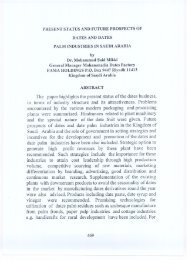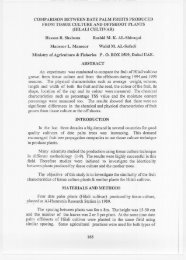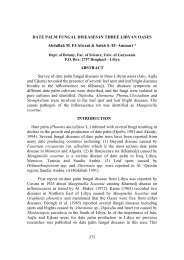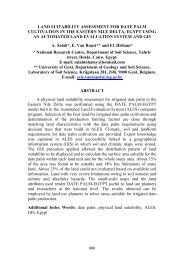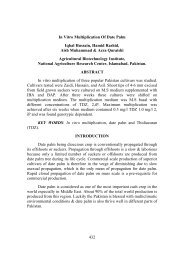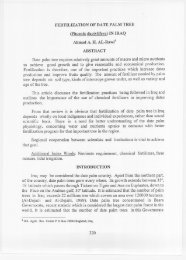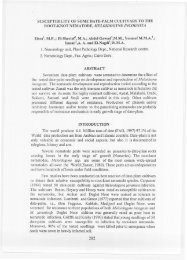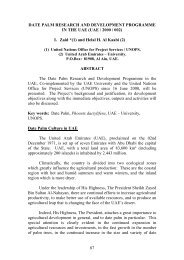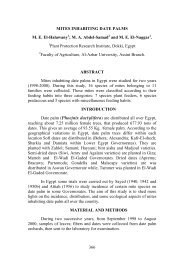THE PHYLLOTAXIS OF THE DATE PALM (PHOENIX ... - Pubhort.org
THE PHYLLOTAXIS OF THE DATE PALM (PHOENIX ... - Pubhort.org
THE PHYLLOTAXIS OF THE DATE PALM (PHOENIX ... - Pubhort.org
Create successful ePaper yourself
Turn your PDF publications into a flip-book with our unique Google optimized e-Paper software.
<strong>THE</strong> <strong>PHYLLOTAXIS</strong> <strong>OF</strong> <strong>THE</strong> <strong>DATE</strong> <strong>PALM</strong>(<strong>PHOENIX</strong> DACTYLIFERA L.)Michel FerryScientific Director.Research centre on date palm and arid land farming system.Apartado 996. 03201 Elche. SpainE-mail: ferry@abserver.esABSTRACTMuch confusion exists concerning the date palm phyllotaxis. A studyof the leaves arrangement of a large number of date palms has pennitted toclarify very precisely, the phyllotaxis pattern of this specie. It has alsopermitted to discover a correlation between a morphological leaf characterand phyllotaxis. A simple method is described to numerate and count thedate palm leavesAdditional Index Words: Phoenix dactylifera, morphogenesis, datepalm leaf, parastichies, modelisation, architectureINTRODUCTIONThe phyllotaxis, that, strictly speaking, corresponds to thearrangement of the leaves, has generated for centuries a very specialinterest. The science of phyllotaxis has been enlarged to the regulardisposition of others parts of the plants like, for example, flowers or pinecone scales. It is still a very actual subject of multidisciplinary study and,often, of controversy (Douady, couder 1993; Cottignies, 1993).The papers on the study of the phyllotaxis of palms are not numerous.Tomlinson dedicates a small paragraph to this subject (Tomlinson, 1990).The more numerous publications are ofDavis and concern different palmsspecies and especially the coconut palm (Davis, 1963, 1970). But Davisdoes not present any infonnation on the.date palm although he gives someresults on a neighbour specie, Phoenix canariensis (Davis, 1970).Concerning the Canary Islands palm, he gives a strange result saying thatthis palm has thirteen spirals (contact spirals? one side? maximum?). Infact, Davis observations of palms phyllotaxy demonstrate that risks ofconfusion are frequent in studies on phyllotaxis. This fact has been 'emphasised by Jean (Jean, 1994).559--- - --
Fig 1: shematic representation of the chronological spiral in the inner partof the crownFor the about 2000 date palms studied, I have just observed for one ofit a change of rotation direction of this curve. I will explain it more indetail farther on.The dissection of adult trees indicates that this curve is perfectlyrespected as well in the external part of the foliar crown as in its inner part.In an adult tree, the number of hidden leaves is similar to the number ofvisible ones. The last or youngest inner leaves (around 1 mm length) forma very small reverse cone in the centre of which is located the terminalmeristem. This reverse cone presents a very interesting problem ofmorphogenesis whose study would give precious informations on thesimple but astonishing palm meristems (Fig 2).;.. -~.., .. ","-. -",'".,",..,- .Fig 2: apex with its peculiar reverse cone morphology561- ---
The chronological curve constitutes a regular spiral in the upper partof the date palm that has a conic shape. As a consequence of the absence ofdiameter growth, it gets a very flattened helix form below the cone, where.the trunk has reachedits maximumfinaldiameter.The chronological curve is easy to follow in the inner part of thecrown. It is still easy to follow with the group of central spear shape leaves(leaflets still jointed and folded along the rachis) and the first rows belowit. But, below these leaves, it is next impossible to do it by a directobservation as the chronological consecutive leaves are no more in contact.To locate the chronological curve in this part or lower in the trunk, it isnecessary to use the parastichies. The parastichies are visible helices thatthb leaves draw along and around the trunk. I will give a more detailed. description farther on.Threetypes of parastichiescanbe easilyidentified.They constitute a sufficient number to determinate accurately the wholephyllotaxy of the crown and to follow the chronological curve till the basisof the trunk.I do not want to enter here in the debate concerning the Plantefolfoliar helices (Loiseau, 1969). But, once identified this chronologicalcurve, there is no need to look for eventual foliar helices to describeaccuratelythe datepalmphyllotaxis. .Once (one palm for 2000), in spite of many attempts, it has not beenpossible to identify this chronological spiral. The dissection of this palmgave the explanation of this failure: the leaves <strong>org</strong>anogenesis wasexceptional; the leaves were jointed by their sheath and, then, thephyllotaxis pattern was not spiral but whorled (photo no 3).7-~ i-. . JFig 3: abnormal whorled phyllotaxis562-- ----
The rank of all the leaves of the centre part of the external crown cannext be established by looking for each successive leaf: each one will befound more or less in the middle of the opposite quarter (135 degrees) onthe left or to the right according the chronological curve direction. To findthe successive leaves, it is not necessary to determine the exact value ofdivergence angle.A method to establish all the leaves ranks with the parastichiesOnce the chronological curve direction is established, a simplemethod allows to determine the ranks of all the leaves.The parastichies are helices in the cylindrical part of the date palms.They constitute spirals in its conic part. Three of these helices aregenerally easy to recognise: the helices 3, 5 and 8; these figures means thatalong these helices the differences of rank between two leaves arerespectively 3, 5 and 8. That means also because of geometrical reasons,that the date palm has 3 helices 3,5 helices 5 and 8 helices 8. Palms canalso exhibit a phyllotaxis pattern that makes visible the helix 13.To locate these helices, I will present the pattern for a date palm witha right-hand chronological helix (photo no 4).Fig 4: a right-hand phyllotaxy564-----
Looking at the base of any chosen leaf (rank n), the closest lowest leafabove it and at its right belongs to the helix 3 (p+3), the closest lowest leafabove it and at its left belongs to the helix 5 (n+5); the leaf of the helix 8(n+8) can be encountered and so confinned by two ways: the closestlowest leaf above the leaf n+5 and at its right (n+5+3) or the closest lowestleaf above the leaf n+3 and at its left (n+3+5). When these leaves havebeen encountered it is easy to find the leaves below (n-3, n-5, n-8) and soto visualise the helices. Step by step, it is easy to establish the relativeranks of all the leaves. .For a date palm with a left-hand chronological curve, the relativeposition of the leaves will be exactly symmetric: n, n+3 at its left, n+5 at itsright, n+8 at its left (Fig 5).Fig 5: a left-hand phyllotaxyThe helices 3 and 8 wind in the same direction as the chronologicalcurve and the helix 5 in the opposite direction.The leaves of the helix 13.are also easy to distinguish although thishelix were not a contact parastichy. The leafn+13 is the closest lowest leafbetween the leaves number n+5 and n+ 8. The helix 13 winds usually inthe opposite direction of the chronological curve but, with some date palmsand varieties, it is very easy to recognise because it is in a vertical positionor close to this position, constituting a more or less perfect orthoparastichy.These date palms are very spectacular with their leaves superposed (Fig 6).565---
Fig 6: the orthoparastichy 13Because of the perfect geometrical pattern of the date phyllotaxis, if amistake has been done in establishing either the rotation direction or theparastichies, it will appear obligatory and rapidly: it will be impossible togive a unique and coherent rank at each of the leaves observed.One has to be careful in establishing the parastichies that change troma helix form to a spiral one in the cone part and that draw up more andmore trom the base of the cone to its top.The parastichy method to establish the direction of the chronologicalcurve.It is not always possible to climb at the top of the tree to study therelative disposition of the spear leaves for establish the direction of thechronological curve, an other method can be used based on what has beendescribed before, the identification of the parastichies.Looking at one remaining leaf base or one leaf scar, the slopes withthe surrounding bases or scars are drawn: 3 slopes can usually be traced:the more horizontal one corresponds to the helix 3, the helix 8 has a greaterslope in the same side; the helix 5 has an intermediate slope in the oppositeside (photo 7).566-- -- - -- -
Fig 7: a right-hand phyllotaxy date palm; the 4 slope marks drawn on thecentral leaf base correspond to the parastichies 3 and 8 at theright, 5 and 13 at the leftA risk of error exists with patterns where the slope of helix 3 is veryhorizontal and the bases or scars corresponding to this helix, a bit far tromeach other, are hidden by the bases or scars of the helix 8. This last one canbe confounded with helix 5 and consequently a mistake can be done withthe direction. But, this mistake can be discovered easily by establishing theranking of the scars all around the palm at the same level to come back tothe initial scar: this one should receive a new rank, differing by one unitfrom the initial one, that constitutes an absolute proof of the mistake.If this method is used, the verification indicated here above has to berealised.The date palm foliage winding and deviation: two morphological traitsof the date palm foliage and their correlation with phyllotaxisTwo peculiar morphological characteristics of the date palm leaf thatis, for the first one, usually neglected and, for the second one, ignored,have to be considered.567- - - --- ----
._n ___ _ -- - _..'--Fig 8: leaf winding and deviationThe first characteristic is what few authors have taken inconsideration and called the leaf winding (Toutain, 1979). A rightdefinition of this parameter is not easy. We must consider two plans todescribe it: one plan is constituted by the axis of the leaf(cental basalportion of the rachis) and the vertical axis of the date palm at the base andthe centre of the leaf; the other plan is the medium plan of the leaflets (leafplan). This last plan is more problematic because, with the growth and theageing of the leaf, it differs from the low leaflets to the terminal ones andloses its plan appearance with the increasing curving of the leaf. Mostgenerally the angle between these two plans is not right but the leaf planwinds to the left or to the right.The second characteristic concerns the end of leaf rachis. As probablya mecanical consequence of the winding of the leaf, the last portion of theleaf rachis is gep.erallynot straight but curved in the same direction as thewinding. I gave to this leaf morphological characteristic (usefull regardingphyllotaxis and, according to my information, never mentioned till now)the name "deviation" to avoid confusion with the leaf curvature (Nixon,1950).I have established the direction of the winding angle and of thedeviation of the leaves of the 2000 date palms studied. I have found that,for each of the date palm observed, all the leaves close to the spire (centralspear shape leaves), excepted few leaves sometimes, presented the samewinding and deviation direction,. Very often, this is also true for all theleaves of the same date palm.568- - - - - - --
It is therefore possible to attribute to any date palm what I have calleda winding and deviation foliage direction.More old is the leaf more great are generally the winding and thedeviation; leaves of certain palms can develop a beginning of helixwinding and sometimes, two opposite directions of winding between thebase and the terminal part. The intensity (and not the direction) of thewinding angle and of the deviation and the final shape of leaf plan aremorphological traits genetically controlled but sensitive to environmentalconditions.Now, I have found that, for all the date palms observed, without anyexception, the winding and deviation direction was identical to thechronological curve direction. Therefore, it can be concluded that there is astrong morphogenetic link between the leaves phyllotaxis and these traitsof the leaf morphology.Consequently, it was not surprisiong to find that these leafmorphological characteristics have some identical aspects as thechronological curve direction: equal distribution between left and rightdirections, no clonal trait.By counting the number of leaflets of the right side and of left sides, Ihave also established that the difference of number that may occur betweenthe two sides, is not correlated with the winding direction.Because of its relation with phyllotaxis, the establishment of thewinding and deviation direction constitutes an other way to find thechronological curve direction.CONCLUSIONSThe various methods presented in this paper to establish the date palmleaves distribution should permit to study more deeply the phyllotaxis ofthis specie. Date palms present different phyllotaxis patterns. The accurateanalysis of these differences can be realised. This research could give someinteresting new keys on the question of phyllotaxis.569- -- - - - -- ---- -- - ---
Concerning the date palm, the chronological curve represents , aperfect and constant response to explain the date palm phyllotaxis. There isno raison to distinguish this curve with the ontological spiral. The twoexceptions described in this paper constitute at the contrary elements thatgive force to this hypothesis. One of these two exceptions, the change ofdirection of the chronological spiral, fits strangely well with the theory ofthe first available space to explain phyllotaxis (Snow, 1962).The link that has been established between leaves chronological curveand two traits of leaves morphology of course reinforces also thehypothesis of the morphogenetic signification of the chronological curve.The practical interests of the results and methods present in this paperare numerous: easy calculation of the total number of leaves or of theleaves production (Ferry, 1988), sampling of leaves of the same rank,rankihg of the inflorescences and of the bunches, accurate phenology withreference to the position, leaves and palm architecture modelisation.LITERATURE CITEDBouguedoura N. Contribution a la connaissance du palmier dattier,Phoenix dactylifer L.; Etude des productions axillaires. These de Doctorat,Univ. d' Alger, 90p.Cottignies A., 1993. Courrier sur les spirales vegetales. La Recherche.24/251: 736.Davis T.A., 1963. The dependance of yield on asymmetry in coconutpalms. J. Genetics, 58:186-215.Davis T.A., 1970. Fibonacci numbers for palm foliar spirals. Acta.Bot. Neer. 19(2): 249-256.Douady S., Couder Y., 1993.La physique des spirales vegetales. Larecherche, 24/250: 26-35.Ferry M., Toutain G., Desfonds V., Louvet J.M., 1988. Morphologicaldifferences' in the developement of date palm vitroplants of variousvarieties. Proc. Symp. on date palm tissue culture, Bagdad, pp 1-16.Hilgeman R.H. , 1951. The differentiation, growth and anatomy of theaxis, leaf, axillary bud, inflorescences and offshoot in Phoenix dactylifera.Ph. D. Thesis, Univ. California, Los Angeles, 140p.570-- - ---
Jean R.V. Phyllotaxis. A systemic study in Plant morphogenesis.Cambridge Univ. Press, 386p.Loiseau J.E., 1969.La phyllotaxie. Masson, Paris, 223p.Nixon, 1950. Imported varieties of date in the United States. no 834.USDA. 145p.Plantefol L., 1946. Fondements d'une theorie phyllotaxique nouvelle.Annales des Sciences Naturelles: Botanique, 11/7: 153-229.Snow M., Snow R., 1962. A theory of the regulation ofphyllotaxisbased on lupinus albus. Phil. Trans. Roy. Soc. London. 244B: 483-513.Tomlinson P.B., 1990. The structural biology of palms. ClarendonPress, Oxford, 477p.Toutain G., 1979. Dossier technique. Enquete en palmeraie dattiere.GRET. Paris. 60p.571



